
About UsThe Numismatic Bibliomania Society is a non-profit organization promoting numismatic literature. For more information please see our web site at coinbooks.org SubscriptionsThose wishing to become new E-Sylum subscribers (or wishing to Unsubscribe) can go to the following web page link MembershipThere is a membership application available on the web site Membership Application To join, print the application and return it with your check to the address printed on the application. Membership is only $15 to addresses in the U.S., $20 for First Class mail, and $25 elsewhere. For those without web access, write to: David M. Sundman, Secretary/TreasurerNumismatic Bibliomania
Society AsylumFor Asylum mailing address changes and other membership questions, contact David at this email address: dsundman@LittletonCoin.com SubmissionsTo submit items for publication in The E-Sylum, just Reply to this message, or write to the Editor at this address: whomren@coinlibrary.com
BUY THE BOOK BEFORE THE COINYou won't regret it! |
- WAYNE'S WORDS: THE E-SYLUM SEPTEMBER 21, 2008
- DAVID F. FANNING OCTOBER 28, 2008 NUMISMATIC LITERATURE SALE UPDATE
- NEW BOOK: AMERICA'S MONEY, AMERICA'S STORY (2ND EDITION) BY DR. RICHARD DOTY
- NEW BOOK: AMERICA'S STATE QUARTERS BY DAVID GANZ
- TREASURE IN THE CELLAR NEWSREEL VIDEO NOW ONLINE
- NANCY GREEN ON BOOK TITLES
- MORE ON UNCUT SIGNATURES IN NUMISMATIC BOOKS
- YOU MIGHT BE A NUMISMATIC BIBLIOPHILE IF ...
- NOTES ON IDENTIFICATION DISCS OF UNION SOLDIERS IN THE CIVIL WAR
- MORE ON COLLECTOR K.P. AUSTIN
- ANSWER: LYMAN LOW'S JULY 1903 CATALOG 1892-O MICRO HALF INFO FOUND
- MORE ON THE BYRON REED NUMISMATIC COLLECTIONS
- MORE ON THE J.N.T. LEVICK PHOTO
- ALAN WEINBERG REPORTS ON THE HERITAGE ROUSE/NAFTZGER AUCTION
- READERS RESPOND: WILL EBAY PAYMENT POLICY CHANGE AFFECT COLLECTIBLES MARKET?
- MORE ON THE MOST POPULAR PORTRAITS ON COINS AND MEDALS
- THOUGHTS ON THE 1876 CENTENNIAL C.A.G.E MEDAL MYSTERY
- QUIZ ANSWER: CANADIAN COIN NEWS
- QUIZ QUESTION: CLARK, GRUBER AND COMPANY TV EPISODE
- LANGE PROVIDES BACKGROUND ON RESEARCHING COIN BOARD MAKER OBERWISE
- DICK JOHNSON: MY FIRST LIBRARY OF CONGRESS BOOK SALE
- THE ESPRESSO BOOK MACHINE: AN ATM FOR BOOKS
- NEW GOOGLE PUSH TO DIGITIZE AND INDEX NEWSPAPER ARCHIVES
- HIGHWAY CLOSED AS TRUCK CRASH SPEWS NICKELS ONTO ROADWAY
- CORRECTIONS TO PRIOR E-SYLUM ARTICLES
- CHINESE COIN A MYSTERY TO 19TH-CENTURY NEW YORK TAVERN DIG SITE
- COUNTERFEIT KING'S COIN PRESS TO BE AUCTIONED
- ARTICLE: WHY LIBRARIES ARE BACK IN STYLE
- SOME SPOOKY BOOKPLATES FOR HALLOWEEN
- SO WHAT'S THE DEAL WITH THEESYLUM.COM?
- WOMAN USES UNCUT PAPER MONEY SHEETS TO WRAP PRESENTS
- FEATURED WEB PAGE: WEIGHTS & MEASURES
WAYNE'S WORDS: THE E-SYLUM SEPTEMBER 21, 2008
 Among our recent subscribers are Rod
Frechette of the Albuquerque Coin Club, courtesy of Bob Laetare, and
Oswaldo M. Rodrigues, Jr. Welcome aboard! We now have 1,188
subscribers.
Among our recent subscribers are Rod
Frechette of the Albuquerque Coin Club, courtesy of Bob Laetare, and
Oswaldo M. Rodrigues, Jr. Welcome aboard! We now have 1,188
subscribers.This week we open with word from David Fanning concerning his upcoming literature auction, and announcements of two new numismatic books. Next, Len Augsburger publishes online an old newsreel relating to his recent book, Treasure in the Cellar.
We have many comments and follow ups this week on previous articles, including uncut signatures, collector K.P. Austin, and J.N.T. Levick. Next, David Lange provides background on his research into coin board maker Oberwise, and Dick Johnson reminisces about attending his first Library of Congress duplicate book sale.
In the news, technology advances continue to revolutionize the availability of rare and historical material for numismatic researchers, zillions of nickels spill onto a roadway, and a counterfeiting king offers tips for buyers of his coin press, now being sold in a police auction.
To learn about the Chinese coin dug up at a New York archeological site and the 1243-dated coin "found in an Ohio Rock", read on. Have a great week, everyone!
Wayne Homren
Numismatic Bibliomania Society
DAVID F. FANNING OCTOBER 28, 2008 NUMISMATIC LITERATURE SALE UPDATE
David Fanning wants everyone to know that due to a storm he was without power from last Sunday afternoon through Thursday night and has had only intermittent access to e-mail and no access to personal e-mails during that time. If you've written him recently, please be patient: he will get back to you if he hasn't already. The catalogue for his auction is at the printer and the closing date of October 28 is still good. The catalogue will be available on his Web site, www.fanningbooks.com , shortly.I also checked in with Mark Borckardt at Heritage, who writes:
NEW BOOK: AMERICA'S MONEY, AMERICA'S STORY (2ND EDITION) BY DR. RICHARD DOTY
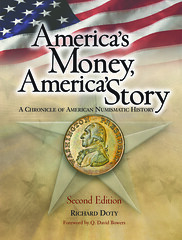 Next month the second edition of Dr. Richard
Doty's book, America's Money, America's Story will be published by
Whitman. The hardcovered 224-page work retails for $26.95. The first
edition was published by Krause Publications in 1998. I have a softcover
version of the first edition in my library - was there a
hardbound?
Next month the second edition of Dr. Richard
Doty's book, America's Money, America's Story will be published by
Whitman. The hardcovered 224-page work retails for $26.95. The first
edition was published by Krause Publications in 1998. I have a softcover
version of the first edition in my library - was there a
hardbound?Whitman was kind enough to send me some sample pages of the new book. The difference between the two editions is readily apparent - there is a night and day difference in layout and design. The advances in computer imaging, design and layout tools over the last ten years, coupled with the expertise of Whitman's production staff, have made the new edition a work of beauty. Doty's masterful text displayed with new color photos of both coins and historical scenes and figures make this edition the one to have.
The publisher's web site displays this apt description of the book and its place in the world of American nonfiction:
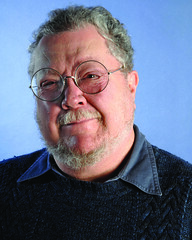 Perhaps no other author is in a better position
to explore American coinage than Richard Doty, senior curator of
numismatics at the National Museum of American History, Smithsonian
Institution. In this position Doty maintains the nation.s collections of
U.S. and world coins, tokens, medals, and paper and other money.more than
1.6 million objects ranging from ancient silver to modern-day credit
cards. Formerly a professor of U.S., Latin American, and world history,
Doty has authored and edited numerous books, and written more than 250
articles and radio scripts concerning numismatics.
Perhaps no other author is in a better position
to explore American coinage than Richard Doty, senior curator of
numismatics at the National Museum of American History, Smithsonian
Institution. In this position Doty maintains the nation.s collections of
U.S. and world coins, tokens, medals, and paper and other money.more than
1.6 million objects ranging from ancient silver to modern-day credit
cards. Formerly a professor of U.S., Latin American, and world history,
Doty has authored and edited numerous books, and written more than 250
articles and radio scripts concerning numismatics. With a professor.s knowledge and a raconteur.s wit, Doty weaves a tale that stretches from Europe to the New World, from pre-colonial days to the modern era. Why were Pine Tree Shillings minted? Why were Mexican silver dollars more common north of the border than U.S. dollars, even long after the Philadelphia Mint got underway? Why was tobacco once used as money (and why did that system go up in smoke)? Why has war brought such dramatic changes to our money? The territory is immense, and Doty is an able and companionable guide.
Hundreds of books have been written about American coins, and thousands on American history. Rarely do the two subjects meet. While coins, tokens, and paper money are part of the chronicle of our country, usually numismatic books don.t delve deep into American history. Conversely, American history books seldom discuss money. This very curious gap is elegantly bridged by America.s Money, America.s Story.
 The book's chapters are titled as follows:
The book's chapters are titled as follows:
- Chapter 1: The Thirteen Colonies and Their Monies
- Chapter 2: The Times That Try Men.s Souls: The War for Independence and Its Aftermath
- Chapter 3: .Hard Money. and the Young Republic, 1789.1830
- Chapter 4: .Rag. Times: The Era of the Private Bank Note, 1789.1865
- Chapter 5: Gold!
- Chapter 6: Civil War and Money.s Change
- Chapter 7: The Gilded Age: America.s Money, 1865.1914
- Chapter 8: Isolation, Depression, and Intervention: America, 1914.1945
- Chapter 9: Cold War and Beyond: 1946 to the Present
Dennis Tucker of Whitman Publishing had made the following offer - the first two subscribers willing to commit to writing a review of Doty's book for The E-Sylum will get a free review copy of the book. Just let me know if you're willing and I'll put you in touch with Dennis.
For more information on the book, see: America.s Money, America.s Story (http://www.whitmanbooks.com/Default.aspx?Page=55&
HTMLName=ReviewUpcoming_0708)
NEW BOOK: AMERICA'S STATE QUARTERS BY DAVID GANZ
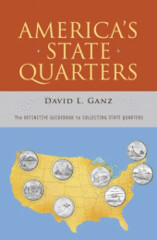 The U.S. Mint.s 50 State Quarters Program, which
ran from 1999-2008, was the most successful coin program in history,
kicking off a collecting craze unlike anything ever seen in the coin
world. The final coin in the program, Hawaii, will be released in August
2008, after which quarters will revert to their pre-1999 designs. All 50
of the collectible quarters are featured in America.s State Quarters, by
numismatics expert David Ganz. As a charter member of the Coin Advisory
Committee to Congress and the U.S. Mint, Ganz deserves .the lion.s share
of the credit for making the 50 State Quarters program a reality.
according to Philip Diehl, the Director of the United States Mint.
The U.S. Mint.s 50 State Quarters Program, which
ran from 1999-2008, was the most successful coin program in history,
kicking off a collecting craze unlike anything ever seen in the coin
world. The final coin in the program, Hawaii, will be released in August
2008, after which quarters will revert to their pre-1999 designs. All 50
of the collectible quarters are featured in America.s State Quarters, by
numismatics expert David Ganz. As a charter member of the Coin Advisory
Committee to Congress and the U.S. Mint, Ganz deserves .the lion.s share
of the credit for making the 50 State Quarters program a reality.
according to Philip Diehl, the Director of the United States Mint.
Information for each state quarter includes:
- Facts about the state (motto, bird, flower, etc)
- History of the design
- Mintage figures
- Grading hints
- Common mint errors
- Investment potential
In addition, the book features behind-the-scenes information about how and why the program was created, as well as how to get the most value from your collection.
David Ganz writes:
David's connection to the program runs deep. His early involvement is summarized by a letter to the editor that U.S. Mint Philip Diehl wrote some 10 years ago (Numismatic News, December 11, 1998):
"The idea of a circulating commemorative has been around the hobby for decades, but frankly, good ideas are a dime a dozen. Far more rare is the ability to move an idea to reality, especially in the rough and tumble environment of Washington, D.C. From my vantage point, the lion's share of the credit for making the 50 States program a reality goes to David Ganz, for his persistence as an advocate, and Congressman Michael Castle for championing the proposal through Congress. David gradually persuaded me of the merits of the proposal, and we at the Mint, in turn, convinced Treasury and the Hill that it was doable. There are other claimants, to be sure, but the hobby owes a debt of gratitude to Congressman Castle and Mr. Ganz.
For more information on the book, see: America's State Quarters: The Definitive Guidebook to Collecting State Quarters (http://www.randomhouse.com/catalog/display.pperl?isbn=9780375722592)
TREASURE IN THE CELLAR NEWSREEL VIDEO NOW ONLINE
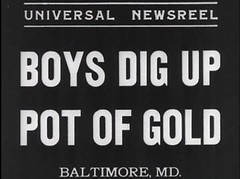 Len writes:
Len writes:
Shown in the video is the facade of 132 S. Eden St., Baltimore, where the find was made, followed by the coins (notice the dilapidated condition of the container), and short statements by the two boys who disinterred this pot of gold. Running his fingers through the gold coins is possibly Harry O. Levin, attorney for the children, who is not shown in the footage but is known to have been present at the time of the filming.
Is this the first "video submission" to the E-Sylum??
To view the newsreel, see: Universal Newsreel: Boys Dig Up Pot of Gold (http://treasureinthecellar.com/video/newsreel.html)
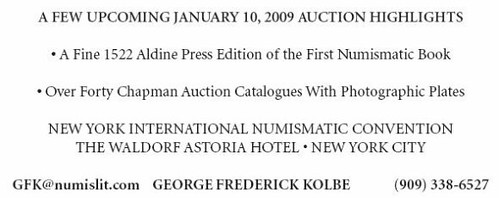
NANCY GREEN ON BOOK TITLES
Former American Numismatic Association Librarian Nancy Green writes:MORE ON UNCUT SIGNATURES IN NUMISMATIC BOOKS
Bill Malkmus writes:Referring to the 1930 revision of F. Sommer Merryweather's Bibliomania in the Middle Ages (originally published in 1849), I had written, "... the copy which this reviewer was privileged to read had been uncut from page 137 on. The knowledge that this was the first time in seventy years that these particular pages had been scanned elicited a feeling of reverence, if not awe, and provided impetus to the project of reviewing this book in The Asylum."
This example falls short by a factor of two of even matching Powell's example, but I thought he might be interested that other readers have had a similar reaction to such a find, and I will look forward to seeing new records set.
David Fanning writes:
Since I know the term isn't familiar to all of our readers (it wasn't to me the first time I heard it a number of years ago), I asked David if he'd define "unsophisticated" for us, in the context of book collecting. He writes:
If "unsophisticated" is generally a good thing in the world of rare books, a "sophisticated" copy can be a bad thing if not done properly. A sophisticated copy in a finely executed quality binding is usually a good thing. A nicely bound copy of a numismatic catalog where the text is from one copy, the title page from another and the plates from a third is also a "sophisticated" copy, and in this case that's NOT a good thing. I've mentioned before the term the late numismatic literature dealer John Bergman used for such books - he said they were "all boogered up".
Steve Tompkins writes:
YOU MIGHT BE A NUMISMATIC BIBLIOPHILE IF ...
Nancy Green writes:
The pickiest numismatic literature collector I know was John Ford. As soon as the December issue of The Numismatist was published, I sent him a pristine set of the year's issues, carefully wrapped. This was after sending several individual issues during the year when I received irate phone calls describing what the Post Office had done to the current issue. In the end, it was easier to send the whole year at once for John's library.
I know what MY wife will say whenever a new box shows up at our door - "What did you buy NOW?" Usually I say (truthfully), that the books are review copies (and not a purchase taking bread off the family table). But do you think she'd believe that numismatic publishers who've been dead for a century were sending me review copies from beyond the grave? Mebbe not...
THE BOOK BAZARRE
NOTES ON IDENTIFICATION DISCS OF UNION SOLDIERS IN THE CIVIL WAR
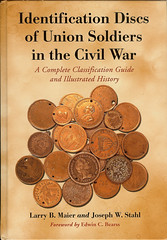 In our September 7, 2008 issue, Steve M.
Tompkins wrote:
In our September 7, 2008 issue, Steve M.
Tompkins wrote:
Alan Weinberg writes:
I put the question to Fred Reed, who first informed us about the book. He writes:
MORE ON COLLECTOR K.P. AUSTIN
An E-Sylum reader writes:He was always accompanied by a woman, who was probably his personal secretary. Her responsibility was to carry a small black volume that contained a list of K.P.'s paper money holdings. K.P. was known to be very astute about paper, with experience gained long before the currently available references were published. K.P. was considered an 'old timer' 30 years ago.
ANSWER: LYMAN LOW'S JULY 1903 CATALOG 1892-O MICRO HALF INFO FOUND
Last week Mark Borckardt wrote:Well, E-Sylum readers came through in spades on this one. Mark writes:
Here's Dave Fanning's response:
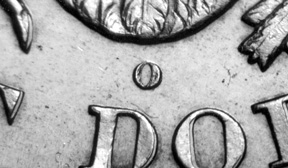
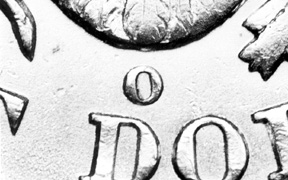
MORE ON THE BYRON REED NUMISMATIC COLLECTIONS
Regarding our earlier queries about Byron Reed and his numismatic collection and library, Saul Teichman forwarded a spreadsheet with 237 entries detailing the auction catalogs in the Reed library. He writes: "Among its highlights is a plated Vicksburg I (Woodward #95)!!"The first five entries are Sotheby catalogs in the 1820s. The first U.S. sale listed is the John F. McCoy collection (1864).
Consignors to sales from 1864 thru 1880 include Joseph Zanoni, Henry Bogert, Joseph J. Mickley, Mortimer Mackenzie, Alfred B. Taylor, John Allen, William Fewsmith, Charles D. Lathrop, Joseph E. Gay, Col. Mendes I. Cohen, James H. Taylor, Ferguson Haines, Henry Holland, Harlow E. Woodward, William Baker, Prof. C. Anthon, Samuel A. Bispham, Alfred Venderer, Samuel Carter, W. P. Titcomb, W. W. Thurston, J. F. B. Litchfiled, and J. Colvin Randall.
The last catalogs listed are plated New York Stamp & Coin Co. sales of 1890 of the Robert Coulton Davis and Lorin Parmelee collections. What a wonderful time capsule of numismatic history!
Larry Lee adds this interesting note on a connection between Reed and J.N.T. Levick:
We have Reed's catalog showing prices realized from the one big Levick sale and Reed clearly won the majority of the lots. I believe Reed attended that particular sale in person and we can trace many of the lots to tokens in his collection, so there is a nice link there. More importantly, it means that much of the Levick token collection is still together as a unit.
I would also be happy to answer any inquiries as to which tokens are included as I do have a complete listing which I (and the city of Omaha) are willing to share.
MORE ON THE J.N.T. LEVICK PHOTO
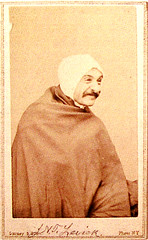 The photo Jim Neiswinter forwarded of Joseph N.
T. Levick was certainly interesting, and has a lot of us perplexed.
The photo Jim Neiswinter forwarded of Joseph N.
T. Levick was certainly interesting, and has a lot of us perplexed.
Ron Thompson writes:
Jim's the creator of the new Neiswinter plate of 1793 large cents. He's learned a lot about Levick in his research, and not everything has been published yet. He sent the following image which he had obtained earlier from Joe Ciccone, archivist of the American Numismatic Society. It's the December 14, 1865 membership certificate for J.N.T. Levick. At that time the organization was the American Numismatic and Archaeological Society (A.N.A.S). -Editor
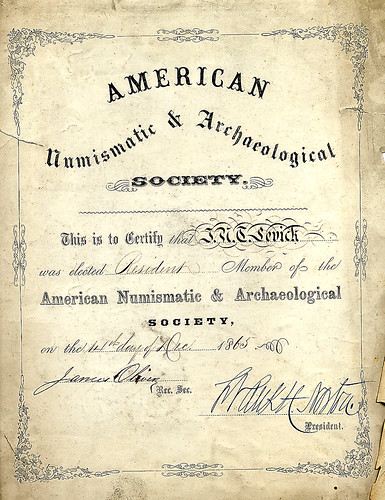
THE BOOK BAZARRE
ALAN WEINBERG REPORTS ON THE HERITAGE ROUSE/NAFTZGER AUCTION
That is not to denigrate the coppers - they just weren't part of Ted's main collection and he was also still buying large cents up 'til approx 1995 after he sold his main collection to Eric Streiner.
The two early copper sales, back to back, were held at the Beverly Hills Crowne Plaza and were intermissioned by a very nice buffet courtesy of Ira & Larry Goldberg. The auction room was mildly crowded but, for the half cents, one could sense a lack of electricity or enthusiasm , quite unlike what one witnessed at the Walt Husak large cent auction. This was not for lack of publicity or marketing as the Goldbergs and Chris Victor McCawley & Bob Grellman did a superb job of that - exhibiting at shows, distributing attractive fliers and publishing many full page ads. It may have been related to the number of pre-Long Beach coin show auctions (five or six) and the current economy.
The nicest 1793 half cent, easily a super-attractive EF-40 (EAC grading) sold for only $30K hammer to a collector. I had thought it would hammer closer to $38K. But there were some big surprises: The 1796 no pole 1/2 cent EAC Fine 15 and slightly porous opened at a high $150K & hammered for $300K to a phone bidder with Tony Terranova the immediate underbidder. The Fine 12 1804 C-2 hammered for $57,500 to CVM, a startling price considering that this well-worn common date half cent may be found unattributed at any coin show. A Fine 12 1805 small 5 stems C-2 hammered for $36K to CVM. An 1831 C-1 Proof 55 hammered for $62.5K to Jim McGuigan. Chris Victor McCawley seemed to dominate the Rouse half cents, bidding for stock and for several clients. At the end of the Rouse half cents I asked whether my perception of a lack of audience electricity was what others perceived. And that was the general impression, with one dealer commenting that "everyone is short of money".
After the buffet dinner, the Naftzger "remainder" early large cents came up and some audience buzz and enthusiasm was again evident although the audience was noticeably thinner in attendance after the half cents had sold.
The "2nd finest" S-10 1793 Wreath cent (actually 4th finest) hammered for $195K to bidder # 97 with phone bidders driving it up over $150K. The MS65 red & brown 1795 S75 lettered edge cent , one of the top 2-3, hammered at $135K to a phone bidder with dealer Joe O'Connor the immediate underbidder.
The astounding 1796 Liberty Cap S84 large cent, the most common variety of the 1796 Liberty Caps, broke all large cent auction records by hammering for $600K (that's $690,000 with the buyers fee) to Richard Burdick , undoubtedly for a client.
It was a beautiful red & brown MS-66 which had been estimated by several knowledgeable people with whom I talked before the auction at $225-300K tops. A magnificent MS-66 red & brown 1797 S140 hammered at $165K to bidder 173 and a beautiful 1798 S179 MS65 brown hammered at $180K , again to Burdick. As did an 1800 S197 MS64 red & brown at $60K, an 1801 MS64 S215 at $80K and a 1807/6 S272 at $150K , all to the same Michigan buyer. That man Richard Burdick , whom I know well, has the taste and eye almost unmatched in American numismatics. His time in the hobby and his extensive show attendance just "walking the bourse floor" contributes mightily to his connoisseurship.
Doug Bird captured a choice 1802 S231 at $62.5 for himself. A magnificent 1803 S243 MS66 red & brown hammered for an astounding $210K. Active participants included Tony Terranova, John Gervasoni, Tom Reynolds, Dan Holmes, CVM, Bird, and some phone bidders (no doubt Steve Contursi was bidding on one) who captured a number of prizes.
There were no one or two bidders who dominated the large cents as happened with the half cents. And there was no evidence of money scarcity or fear of the economy evident in the sale of the Naftzger large cents. Indeed, after the large cents auctioned, another advanced large cent collector opined to me that people with money were scared to put their money into real estate, stocks or bonds and were choosing rare coins instead.
There was one thing that bothered a lot of collectors and which hopefully will be rectified when the middle and late date Naftzger large cents are auctioned next year. Most large cent collectors value pedigrees and original provenance envelopes that accompany a coin, particularly when those envelopes are inscribed in minute detail with comments and prior ownership history in the distinctive green ink handwriting of Ted Naftzger ("God" as he was known).
Examining the large cent auction lots, I often found the envelope scribbled thoughts of REN as interesting as the coin itself! Yet, these distinctively inscribed envelopes, some going back to the 1954 Anderson DuPont Stack's sale, were all scotch-taped to the coin slabs, the tape often ruining or staining the envelopes and in at least one case lifting off the green ink inscriptions !
Archival tape should have been used or the Naftzger envelope enclosed in an attached clear flip. Would you put a piece of sticky scotch tape on a piece of scarce currency? Well, the same applies to any old inscribed coin envelope or famous sale envelope. It literally impairs the appeal and value of the coin itself if the pedigree is important.
READERS RESPOND: WILL EBAY PAYMENT POLICY CHANGE AFFECT COLLECTIBLES MARKET?
Russ Sears writes:
But for a small seller like me, they are not only taking more of my money, but also creating a new set of books for me to keep. Since I claim all of my eBay sales, using PayPal gives me another thing to do. One day, the federal government will determine that eBay is a monopoly and act accordingly.
Dave Lange writes:
Another disturbing move is that eBay keeps dropping hints that it may require sellers to offer free shipping. I see this as a means to extract yet more money from sellers. eBay doesn't receive a percentage of the shipping fee, but by requiring free shipping it would force sellers to again charge more from the buyers to cover expenses, and such higher prices would result in larger fee collections by eBay and PayPal.
In the past year or two there have been so many changes in eBay's policies and functionality that it has become quite frustrating. There seem to have been a lot of changes made simply for the sake of change, and these have forced users to continually relearn something they'd already mastered. I've long been leery of software "upgrades" and similar, seemingly unnecessary changes, but these seem to be irresistable to website engineers and their management. I'm afraid that something that wasn't broken is being rendered nearly useless to me through such frequent "fixes." Am I simply a Luddite, or do others feel the same way?
Phil Iversen writes:
Alan V. Weinberg writes:
It is also apparently true that new eBay registered sellers , who had been totally unregistered with eBay before even as bidders/buyers, are being required to sign up for Paypal. But "older" eBay sellers , even if they'd only been previously buyers, can remain Paypal-free. In other words, I've been registered with eBay as a buyer/bidder since 1998 but have never yet sold anything on eBay. It is my understanding that if I registered sometime in the future as a seller too, I will not be required to accept Paypal. True?
Perhaps an E-Sylum reader who is an experienced eBay seller can straighten out all this confusion. Because if what people are hearing about eBay's soon-to-be -enforced electronic payment requirement is true, this will significantly impact numismatics. Many buyers do not want Paypal and prefer checks, money orders or cash. As it is, I believe starting in January there will no longer be eBay live numismatic auctions ? Is that true? I've seen that in print more than once.
Ya know, all this electronic requirement payment brouhaha sounds suspiciously of violation of anti-trust laws since eBay owns Paypal. Maybe Congress, if they can redirect their attentions from the "important business" they handle (said with tongue- in- cheek), they might investigate this new eBay policy. If nothing else, it is certainly illegal restraint of trade, a federal issue.
MORE ON THE MOST POPULAR PORTRAITS ON COINS AND MEDALS
As for coins, Queen Elizabeth II has to be tops, if not Lincoln, given the sheer volume of coins depicting her.
By the way, Dick Johnson's list was originally numbered, but the numbering wasn.t displayed for some readers. Here's the list again, with numbers. -Editor
- 1. Napoleon
- 2. George Washington
- 3. Abraham Lincoln
- 4. Martin Luther
- 5. John F. Kennedy
- 6. Benjamin Franklin
- 7. Capt. James Cook
- 8. Admiral George Dewey
- 9. Winston Churchill
- 10. Admiral Vernon
THOUGHTS ON THE 1876 CENTENNIAL C.A.G.E MEDAL MYSTERY
Marc C. Ricard writes: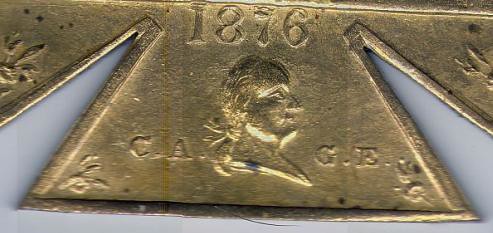
QUIZ ANSWER: CANADIAN COIN NEWS
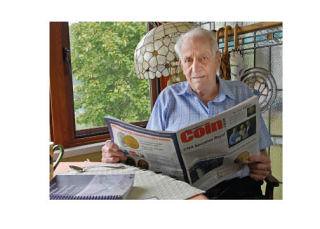 Jeff Starck of Coin World was the first to
answer last week's quiz question. What hobby newspaper is this man
reading?
Jeff Starck of Coin World was the first to
answer last week's quiz question. What hobby newspaper is this man
reading? Answer: Canadian Coin News.
QUIZ QUESTION: CLARK, GRUBER AND COMPANY TV EPISODE
Mark Borckardt writes:- The Rifleman
- Death Valley Days
- Bonanza
- Hee-Haw
LANGE PROVIDES BACKGROUND ON RESEARCHING COIN BOARD MAKER OBERWISE
 Last year I wrote an article for Numismatic
News (Aug. 7, 2007) which told the story of Joseph Oberwise, a Los Angeles
coin dealer and publisher of coin board premium cards during the 1930s and
1940s.
Last year I wrote an article for Numismatic
News (Aug. 7, 2007) which told the story of Joseph Oberwise, a Los Angeles
coin dealer and publisher of coin board premium cards during the 1930s and
1940s.Actually, it would be more correct to say that I described what little was known of him at the time. This wasn't much, consisting mostly of what could be gleaned from federal census records, city directories, old newspapers and his advertisements in numismatic publications. This told me little about the man himself and his family, and it was likewise frustrating that the only photograph I had of him was a grainy image from the Los Angeles Times taken while he was serving as a juror in 1934.
Among those reading this article was Eric Head, an amateur genealogist from Tennessee. He wrote me shortly after its publication with additional information that not only revealed more about Mr. Oberwise but also provided me with a link to the Oberwise descendants. Having never had children or a male sibling, Joseph Oberwise left no heirs under his own name. It is through his sister, Barbara (alternately Barbra) O. Gavron, that the family now traces its lineage, and Mr. Head was able to make this connection I'd missed in my own research.
Armed with the current family name (originally Gawronski), as well Eric's information that several Gavron descendants could be traced to northern California, I began writing to individuals of that name shown in public records to be still living.
I soon received an answer from Robert Gavron, and we arranged to meet at a coin show in Santa Clara, Calif. This proved to be a most fruitful exchange in which he provided me with an Oberwise/Gavron family tree and a photograph of several family members. He also gave me the address of his cousin by marriage, Josie, who is custodian of many family records and photographs. I sent her a copy of my book, Coin Collecting Boards of the 1930s & 1940s: A Complete History, Catalog and Value Guide, which details what I knew already about Joseph Oberwise. Her son Jay responded with the wonderful photographs that accompany this article, as well as a number of family letters that have helped to flesh out the story of Joseph Oberwise.
One incident from Joseph Oberwise's years of producing and distributing coin boards was not so pleasant. John Gavron also recounts how Uncle Joe had a press in the garage back of his coin shop for punching out the holes in each board (always a clever businessman, Joe Oberwise gathered up all of the punched out disks and sold them to local bingo parlors). The machine was motorized, but the cardstock had to be fed and removed by hand. In a hasty moment, Oberwise did not time the operation just right, and the punch press came down on his right hand, costing him the loss of two-and-half fingers. Though he recovered from this grisly accident, he wrote to family members that he'd have to "give up playing baseball and bowling." To emphasize his point, he enclosed a photograph of his mangled hand, all the while assuring his family that he was all right!
The incident described occurred right about the time his coin boards and folders went out of production around 1948, and the two events were probably related.
The legacy of Joseph Oberwise is found in the many surviving coin boards, or premium cards as he labeled them, which today are popular collectibles. It was my pleasure to catalog these boards for my book on the subject, and it was a pleasure, too, to be able to tell the story of this remarkable entrepreneur. I would like to thank Eric Head and the various members of the Gavron Family who so generously provided me with additional information about Joseph Oberwise, as well as the wonderful family photographs which accompany this article.
To read the complete article, see: Family Helps Bring Coin Board Titan to Life (http://www.numismaster.com/ta/numis/Article.jsp?
ad=article&ArticleId=5305)
DICK JOHNSON: MY FIRST LIBRARY OF CONGRESS BOOK SALE
You didn't know the Library of Congress sold books? Well what they sell are duplicates, unwanted surplus books -- copyright deposit books for the most part -- but from other library departments as well. They are gathered in a room on one of the top floors in the main library building, as I recall from fifty years ago.
On the appointed day, I believe I signed up for sick-call, went to the dispensary, got my quota of aspirin, then drove to the Library well ahead of the announced time of opening. Buyers were directed to a room across the hall from the room containing the books for sale. The room was already full of book dealers, scouts and book runners by the time I arrived. Early birds get the worm, I thought. You didn't have to prove you were a bona fide book dealer. I just walked in and took a seat.
At the appointed time doors were opened and the dealers swarmed in. It was a race to the first aisles of book shelves. These were already filled with dealers pulling armloads of books off shelves as I walked by. I entered the first empty isle. Little did I know the library mavens push all the unsold books from previous sales to the furthest aisles. All the new stuff was in the early shelves.
You would be amazed at the stuff that is deposited for copyright: menus, club newsletters, church bulletins, sales literature. Tons of it in this flotsam of American society. But here it sunk to the back shelves.
But I found four treasures - I located three Numismatic Notes and Monographs published by ANS and a copy of John Davenport's European Crowns. It was stamped "Copyright Office / Library of Congress" and the date received. Evidently of the two copies demanded for copyright they only placed one copy in the permanent LC collection and shunted the other over here.
The procedure for the dealers was to stack their desired purchases in the aisle and move on to another aisle. It was verboten even to look at anything on the floor. I passed those early aisles and the shelves were nearly empty within minutes with tall piles on the floor.
It was an easy checkout for me with only four items - price 50 cents each. I may have attended another one or two of these LC sales but stopped when it was no longer productive.
Two decades later it did remind me of the book sales at local libraries. My favorite was at the Mark Twain Library in Redding here in Connecticut. It was spread over a three-day weekend, with a preview Friday night (pay double price marked) and a race for it Saturday morning. And I'll wager every die-hard book buyer will admit at some time to doing what I often did. Cherry pick desired books Friday night and hide them on another table of low interest and hit that table first thing next morning.
Even so, I would bring the family and let them pick a box or two of books for each member while I hit the book tables in order: art, reference, history, then peruse the rest of the stock. The annual Mark Twain book sale outgrew the school auditorium and subsequently filled the gymnasium as well. I'll bet it is still as popular today as it was in the 1970s.
THE ESPRESSO BOOK MACHINE: AN ATM FOR BOOKS
Anne E. Bentley of the Massachusetts Historical Society writes: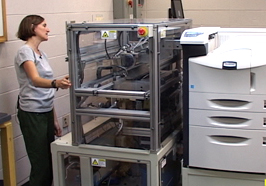 With the installation of a state-of-the-art
book-printing machine at one of its libraries, the University of Michigan
stands at the new frontier of 21st-century publishing, offering printed
and bound reprints of out-of-copyright books from its digitized collection
of nearly 2 million books, as well as thousands of books from the Open
Content Alliance and other digital sources.
With the installation of a state-of-the-art
book-printing machine at one of its libraries, the University of Michigan
stands at the new frontier of 21st-century publishing, offering printed
and bound reprints of out-of-copyright books from its digitized collection
of nearly 2 million books, as well as thousands of books from the Open
Content Alliance and other digital sources.U-M is the first university library to install the book-printing machine. The Espresso Book Machine, from On Demand Books of New York, produces perfect-bound, high-quality paperback books on demand. A Time Magazine "Best Invention of 2007," the Espresso Book Machine has been called "the ATM of books." It was purchased with donations to U-M libraries.
After Oct. 1, the Espresso Book Machine will be operating most mornings during the week, with a selection of titles available for sale.
"This is a significant moment in the history of book publishing and distribution," said Paul Courant, dean of libraries at U-M.
"As a library, we're stepping beyond the limits of physical space," he said. "Now, we can produce affordable printed copies of rare and hard to find books. It's a great step toward the democratization of information, getting information to readers when and where they need it."
The book machine, located in the Shapiro Library lobby on U-M's Central Campus, prints out-of-copyright books from the University's digitized collections. At a cost of about $10 per book, the service is available to researchers, students and the public.
The printing process begins with a reader selecting a digitized book from U-M's pre-1923 collection or from another online source, such as the Open Content Alliance. Most books printed prior to the early 1920s can be reprinted without seeking the permission from whomever holds the copyright. Then the file is downloaded to the Espresso Book Machine, where it is formatted, printed and perfect bound with a four-color cover.
A finished printed book takes 5-7 minutes, depending on the number of pages.
Since 1996, U-M Libraries have digitized nearly 2 million books. The University was the first participant in the Google Book Search program, which digitizes books in libraries throughout the world.
"We are delighted to install the machine at such a prestigious institution where it can access a variety of digital repositories to print high-quality books in about the same time it takes to brew an espresso," said Dane Neller, cofounder and CEO of On Demand Books.
On its Web site, On Demand Books likens the potential impact of the book machine in the 21st century to that of the Gutenberg press in the 15th-century. Mass production and dissemination of books was a major factor in the rise of critical, independent thinking, leading to a renaissance in the arts and sciences.
In the next several years, On Demand Books expects to install Espresso Book Machines in libraries and bookshops around the world. All the machines will be connected by a network, allowing libraries to share and reprint volumes from their collections.
To read the complete article, see: U-M at forefront of new era in publishing (http://www.ns.umich.edu/htdocs/releases/story.php?id=6735)
NEW GOOGLE PUSH TO DIGITIZE AND INDEX NEWSPAPER ARCHIVES
The problem is that most of these newspapers are not available online. We want to change that.
Today, we're launching an initiative to make more old newspapers accessible and searchable online by partnering with newspaper publishers to digitize millions of pages of news archives.
Not only will you be able to search these newspapers, you'll also be able to browse through them exactly as they were printed -- photographs, headlines, articles, advertisements and all.
This effort expands on the contributions of others who've already begun digitizing historical newspapers. In 2006, we started working with publications like the New York Times and the Washington Post to index existing digital archives and make them searchable via the Google News Archive. Now, this effort will enable us to help you find an even greater range of material from newspapers large and small, in conjunction with partners such as ProQuest and Heritage, who've joined in this initiative. One of our partners, the Quebec Chronicle-Telegraph, is actually the oldest newspaper in North America . history buffs, take note: it has been publishing continuously for more than 244 years.
Stories we've scanned under this initiative will appear alongside already-digitized material from publications like the New York Times as well as from archive aggregators, and are marked "Google News Archive." Over time, as we scan more articles and our index grows, we'll also start blending these archives into our main search results so that when you search Google.com, you'll be searching the full text of these newspapers as well.
This effort is just the beginning. As we work with more and more publishers, we'll move closer towards our goal of making those billions of pages of newsprint from around the world searchable, discoverable, and accessible online.
To read the complete article, see: Bringing history online, one newspaper at a time (http://googleblog.blogspot.com/2008/09/bringing
-history-online-one-newspaper.html)
From July 27, 1896
From February 28, 1962:
HIGHWAY CLOSED AS TRUCK CRASH SPEWS NICKELS ONTO ROADWAY
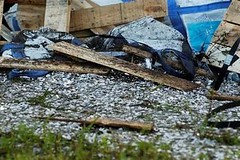 Portions of Interstate 95 were closed . and
sparkling in the morning sun . Wednesday after a tractor trailer carrying
$187,000 worth of nickels crashed, scattering the coins across the road
and killing one person.
Portions of Interstate 95 were closed . and
sparkling in the morning sun . Wednesday after a tractor trailer carrying
$187,000 worth of nickels crashed, scattering the coins across the road
and killing one person.A fatal truck wreck early Wednesday, Sept. 17, 2008. involving a truck carrying a load of nickels near Titusville, leaves spilled coins the roadway. .It.s shiny across the roadway,. said Florida Highway Patrol Trooper Kim Miller. .There are nickels in the grass, across the interstate..
The southbound lanes of I-95 in Brevard County north of Titusville were closed as authorities secured the scene. Miller said the coins were on their way from Philadelphia to the U.S. Treasury in Miami, where they were set to be distributed to banks.
She said one tractor trailer rear-ended another at 5:30 a.m. Wednesday, causing the first truck to run off the road and the second to overturn, spilling some of its 3 million nickels across the road.
Miller said it was not immediately known how many nickels spilled onto the roadway. She said some remained bagged inside the truck.s trailer, and that the Secret Service and U.S. Treasury were on the scene trying to decide how to pick them up .and to make sure nobody touches any of the nickels..
.I don.t suspect they.re going to be picking up these nickels one by one,. she said. .Maybe with shovels..
To read the complete article, see: Spill of $187,000 in Nickels Closes I-95 (http://www.theledger.com/article/20080917/NEWS/809170286
&title=Spill_of__187_000_in_Nickels_Closes_I_95)
CORRECTIONS TO PRIOR E-SYLUM ARTICLES
Nick Graver spotted this one in the story about the J.N.T. Levick photo:Of course, it should be pince nez glasses. Leon Saryan potted a big one in Dick Johnson's comment about the American Numismatic Society and the Hispanic Society of America. He writes:
This is what I published:
Of course, that should be $30 million. Back to Nick Graver, he found one in this note about a J. L. Polhemus counterstamp:
This should have said mid-19th century. Nick spotted a number of others (thanks!) but one's worth mentioning since it.s an easy mistake to make because the words sound so much alike. In this passage, the word medal is used where metal was meant.
Sorry about those, folks. I'm lucky we don't find many more mistakes each week. These bulletins get slapped together in whatever free moments I can find during the week. Now I'll take my turn and point out a problem in a commercial mainstream newspaper:
At one point, Don Weir lived in the Town and Country home where he kept the collectibles, now in the hands of the FBI.
"His estranged wife called the president of the brokerage firm late last week and suggested he might want to come over and take a look at her basement," says Albert Watkins, HFI attorney.
Watkins says much of the money was being held for investors who dealt directly with Weir.
"The company had no knowledge this was being done and certainly that this quantity of gold was being purchased and, of course, it goes without saying that no one had any idea he was maintaining a miniature Fort Knox in Town and Country, Missouri," Watkins says.
Shortly after being confronted with the coin storage situation, HFI's attorney says Weir attempted suicide. He's expected to meet with investigators soon.
To read the complete article, see: Million dollar stash of coins found in St. Louis broker's basement (http://www.bnd.com/430/story/478619.html)
CHINESE COIN A MYSTERY TO 19TH-CENTURY NEW YORK TAVERN DIG SITE
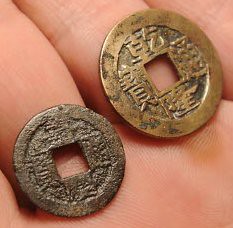 Digging through 200-year-old trash heaps isn't
always glamorous. But a small Asian coin uncovered behind a 19th-century
Latham tavern turned a routine archaeological survey into an international
puzzle.
Digging through 200-year-old trash heaps isn't
always glamorous. But a small Asian coin uncovered behind a 19th-century
Latham tavern turned a routine archaeological survey into an international
puzzle.The copper alloy coin was unearthed as archaeologists combed through the soil behind the old Ebenezer Hills Jr. house. The one-time way station on a busy turnpike between Albany and Schenectady (now Route 7) was the equivalent of a Thruway rest stop when the trip between the two cities could take a day.
Last month, the Albany County Airport Authority moved the house about 200 feet to get the historic building clear of a runway.
The coin, which has a square hole stamped in the center and is the thickness of a dime, was discovered about a foot deep in the soil around a stone feature that may have been associated with an older wing of the building, which dates to between 1805 and 1810, said Corey McQuinn, project director for Hartgen Archeological Associates, the company hired to do the work.
From the site, the coin was shipped to Hartgen's laboratory in North Greenbush, where conservation director Darrell Pinckney placed it in an electrolytic reduction bath, which uses a solution and mild electric current to remove centuries of crust.
The bath revealed Asian markings -- possibly Chinese, Pinckney said.
Hartgen is looking into forwarding photographs of the coin to experts in the field, who may be able to date it based on the markings, which often show the ruling dynasty during which a coin was minted.
"It had to do some traveling," McQuinn said.
Town Historian Kevin Franklin said the source of the coin may always be a mystery, though he offered a few possibilities.
For instance, he said, the United States opened trade with China in the years after the Revolutionary War. An Albany captain named Stewart Dean commanded the ship "Experiment" on a 1785 trading mission to Canton, China.
The Asian coins are generally not very valuable or even rare -- but they can help tell the story of who called a place home, or -- in the case of the Ebenezer Hills Jr. house -- who was likely just passing through.
"The date of the coin would be kind of interesting," Franklin said. "Chinese coinage has been around for thousands of years (and the coins) have popped up all over the place."
To read the complete article, see: How in the world did coin land in Latham? (http://timesunion.com/AspStories/story.asp?storyID=720903)
COUNTERFEIT KING'S COIN PRESS TO BE AUCTIONED
So good, that he spent more than two years in federal prison in 1998 for his handiwork and was paid $18,000 by the feds as a consultant to explain why his manufacturing dies outlast those at the U.S. Mint.
So good, that he was the featured .Counterfeit King. in a History Channel documentary on Breaking Vegas and made his own video, How to Win at Slots, after advising casinos how to detect fake tokens.
So good, that in November 2006, when investigators from three states and two federal agencies began investigating high-quality counterfeit tokens showing up in casinos up and down the East Coast, they ended up on Colavecchio.s doorstep in Pawtucket once again.
Now, the coin-making machinery, the blank metal strips and blank coins seized from Colavecchio.s property two years ago are going up for auction tomorrow at 10:30 a.m. at S.J. Corio Co., in Warwick. Colavecchio, who has been out on $25,000 bail with surety, requiring 10 percent of the amount in cash, or the full amount in property, since his arrest in 2006, noticed his equipment listed in a newspaper advertisement for the auction.
.I might go,. Colavecchio, 66, said about tomorrow.s auction. .I could tell [potential buyers] a lot of stuff. They may know how it works, but it.s been, let me say, .modified. . so some things are not exactly as they seem..
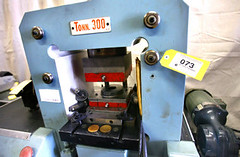 Sal Corio Sr., president of the auction house,
said that the company has been getting calls about some of the machinery,
which includes a blanking tool that cuts the coins. shapes, and an EDM
machine that burns the image onto the metal, a Mario Dimaio coining press,
a roller mill machine, an electric plating machine, the strip stock metal
used to make coins, and a coin comparator device, made for the gaming
industry, used to validate coins for slot machines.
Sal Corio Sr., president of the auction house,
said that the company has been getting calls about some of the machinery,
which includes a blanking tool that cuts the coins. shapes, and an EDM
machine that burns the image onto the metal, a Mario Dimaio coining press,
a roller mill machine, an electric plating machine, the strip stock metal
used to make coins, and a coin comparator device, made for the gaming
industry, used to validate coins for slot machines. The state police believed that Colavecchio was making tokens for slot machines at Foxwoods and Mohegan Sun, the Trump Marina Casino and Trump Plaza Casino in New Jersey, Harrah.s casino in Las Vegas, among others.
Despite the ban, Colavecchio had continued gambling at casinos .. wearing wigs and dressing as a woman to avoid being recognized, O.Donnell said.
.He.s a crafty criminal and that.s what he does. He makes no bones about it,. O.Donnell said.
To read the complete article, see: Counterfeit coin-making machinery up for bid tomorrow at police auction (http://www.projo.com/news/courts/content/
auction_advance_09-19-08_SOBKVT7_v32.152336e.html)
ARTICLE: WHY LIBRARIES ARE BACK IN STYLE
In the latest annual National Association of Home Builders consumer survey, 63% of home buyers said they wanted a library or considered one essential, a percentage that has been edging up for the past few years. Many mass-market home builders are including libraries in their house plans, sometimes with retro touches like rolling ladders and circular stairs.
Jeani Ziering, an interior designer in Manhasset, N.Y., says the newfound popularity of libraries is part of a general movement toward traditional design and dicor. "When the economy turns bad, people turn to the classics," she says. Libraries are especially appealing during anxious times because they project coziness and comfort, she adds.
What can make libraries more soothing than other formal rooms isn't so much books but the framed family photographs, awards and mementos that share the shelves and define a family's interests and identity, says McLean, Va., architect Chris Lessard. "They're memory rooms," he says. Because libraries are public rooms, oftentimes the books are purely decorative and don't say as much about the family who lives there. The books that people really read, like paperback novels and how-to guides, often are kept out of sight elsewhere in the home.
Still, some homeowners are book lovers. Michael Burkitt and his wife, Roberta, own an estimated 9,000 books, all hardbound, which they keep in two formal libraries in their new, 5,800-square-foot home in Reno, Nev., and their 3,800-square-foot vacation house in Newport Coast, Calif. Mr. Burkitt, 65, the recently retired co-owner of a structural-plastics firm, says he's been too busy working most of his life to read even a fraction of them. But he enjoys relaxing among them in what he considers his "sanctuaries" -- one paneled in dark wood, the other in white -- free from distractions like computers. "They're the wombs of my homes," he says.
To read the complete article, see: Why Libraries Are Back in Style (http://online.wsj.com/article/SB122117550854125707.html)
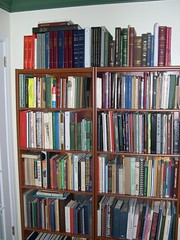
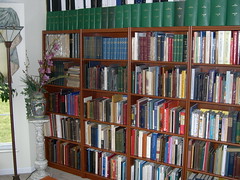
To view full-size versions of the photos, see: http://www.flickr.com/photos/coinbooks/2868776973/sizes/l/
http://www.flickr.com/photos/coinbooks/2868776901/sizes/l/
SOME SPOOKY BOOKPLATES FOR HALLOWEEN
Speaking of libraries, a blog post I came across this week illustrated some interesting skeleton letterpress bookplates. They're expensive, but with Halloween around the corner some bibliophiles (who are known to have odd tastes!) may have interest. They look too large for my taste - I've not added bookplates to library (yet), but if I do I'll probably opt for something "tastefully" small.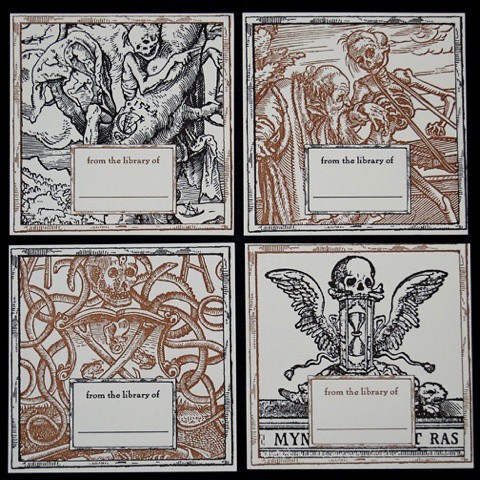
To read the complete article, see: Skeleton letterpress bookplates (http://www.boingboing.net/2008/09/18/skeleton-letterpress.html)
SO WHAT'S THE DEAL WITH THEESYLUM.COM?
John writes:
The song Ultrabeat - Esylum (i go crazy) is that our song?
Here, they actually use the hyphen :
I found dozens of other web links and sites on Esylum. Is this a musical group? Do we own the domain?
When we first looked for a web address for the Numismatic Bibliomania Society I first tried the obvious (nbs.org), only to discover it had been taken by the National Brotherhood of Skiers association. Back then I think it was called the National Black Skiers association. Anyway, they beat us to it, fair and square.
When I started The E-Sylum I didn't think about getting a domain name separate from NBS, but in hindsight that would have been a good idea. -Editor
WOMAN USES UNCUT PAPER MONEY SHEETS TO WRAP PRESENTS
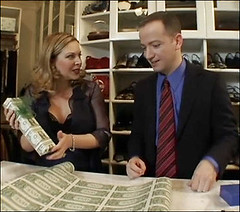 Need more proof that the money meltdown is
making people nuts? Consider lobbyist Edwina Rogers, who's catching hell
for wrapping presents in $1 bills.
Need more proof that the money meltdown is
making people nuts? Consider lobbyist Edwina Rogers, who's catching hell
for wrapping presents in $1 bills. "I'm getting death threats," Rogers told us yesterday. "I'm just a little girl from Alabama, so the whole image is wrong."
The Republican lawyer was filmed for the pilot of "PowerHouse," a peek inside homes of local VIPs -- hers being an 18,000-square-foot McLean mansion. Rogers shared one of her trademarks: Covering small gifts with sheets of uncut U.S. currency. A clip was posted on Hotline last month, then made its way onto blogs and the "Colbert Report" Monday as a symbol of K Street's wretched excess.
That's so not what she meant. The health policy lobbyist (previous gigs in the Senate and White House) started wrapping inexpensive presidential cuff links in dollars 10 years ago -- as small, under-$20 thank-you's that would comply with ethics rules. "I was trying to be perfectly legal, but be unique and interesting," she said. "I only use it on tiny gifts." Friends love it, especially foreigners.
And yes -- you too can wrap your presents in cash. The "Buy Paper Money" link on the Treasury Department's Web site offers uncut sheets of 32 bills (for $55); 16 $1 bills (for $33) -- or if you're feeling flush, sheets of $2, $5, $10, $20 and $50 bills.
But take note: While uncut currency is legal tender (you can cut around the bills), slicing them in half (as Rogers does in the clip) is technically considered defacement.
FEATURED WEB PAGE: WEIGHTS & MEASURES
This week's featured web page is on weights & measures and is recommended by John and Nancy Wilson, who write:http://www.weights-and-measures.com/
